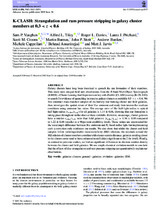| dc.description.abstract | Galaxy clusters have long been theorized to quench the star formation of their members.
This study uses integral-field unit observations from the K-band MultiObject Spectrograph
(KMOS) – Cluster Lensing And Supernova survey with Hubble (CLASH) survey (K-CLASH)
to search for evidence of quenching in massive galaxy clusters at redshifts 0.3 <z< 0.6. We
first construct mass-matched samples of exclusively star-forming cluster and field galaxies,
then investigate the spatial extent of their H α emission and study their interstellar medium
conditions using emission line ratios. The average ratio of H α half-light radius to optical
half-light radius (re,H α/re,Rc ) for all galaxies is 1.14 ± 0.06, showing that star formation is
taking place throughout stellar discs at these redshifts. However, on average, cluster galaxies
have a smaller re,Hα/re,Rc ratio than field galaxies: re,Hα/re,Rc = 0.96 ± 0.09 compared
to 1.22 ± 0.08 (smaller at a 98 per cent credibility level). These values are uncorrected for
the wavelength difference between H α emission and Rc-band stellar light but implementing
such a correction only reinforces our results. We also show that whilst the cluster and field
samples follow indistinguishable mass–metallicity (MZ) relations, the residuals around the
MZ relation of cluster members correlate with cluster-centric distance; galaxies residing closer
to the cluster centre tend to have enhanced metallicities (significant at the 2.6σ level). Finally,
in contrast to previous studies, we find no significant differences in electron number density
between the cluster and field galaxies. We use simple chemical evolution models to conclude
that the effects of disc strangulation and ram-pressure stripping can quantitatively explain our
observations. | en_US |

